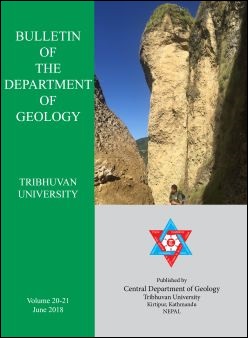Geological Study of the Lesser Himalaya in the Kusma-Baglung Area, Western Nepal
DOI:
https://doi.org/10.3126/bdg.v20i0.20721Keywords:
Lesser Himalaya, Nepal, Nawakot Complex, River terrace, MetamorphismAbstract
Geological study was carried out along the Kaligandaki and Modi Khola valleys in west Nepal. The area comprises the rock of Lesser Himalayan metasedimentary sequence. Main rock types present in the area are quartzite, phyllite, metasandstone and psammatic phyllite. Schist and gneiss are present in some parts. Ulleri Gneiss is explored in the area. Kusma-Baglung area comprises the spectacular terrace deposits formed at the Quaternary time by the Kaligandaki River and the Modi Khola. The terrace extensively comprises clast of limestone, marble, gneiss, quartzite, schist, phyllite ranging in size from fine matrix to huge boulders derived from the Higher Himalaya.
Bulletin of Department of Geology, vol. 20-21, 2018, pp: 29-36
Downloads
Downloads
Published
How to Cite
Issue
Section
License
© Central Department of Geology, Tribhuvan University, Nepal

